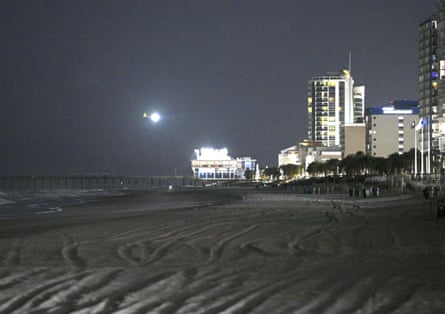Last Friday, Enildo Altamar and his neighbours looked up into the clear morning sky above Arroyo de Piedra, near Colombia’s Caribbean coast, and saw a white orb floating above them, a smaller version of the moon.
“We are used to seeing drones in the area as they monitor local mines but they fly around, whereas this thing was massive and just hung in the air,” Altamar said.
Soon his phone was pinging with messages from panicked friends in surrounding towns asking what the mysterious object could be. As if in some Hollywood sci-fi movie, people came out of their houses, gazing towards the heavens with wonder and fear.
“There was a lot of anxiety and nerves,” Altamar said. “I later realised it could’t be a UFO because they don’t let themselves be spotted easily. This must be something different. But I never would have guessed it was a spy balloon!”
At the time, much of the world was focused on the Chinese balloon crossing US airspace, which was ultimately shot down in dramatic style by a US F-22 Raptor jet off the South Carolina coast.
What the people of Arroyo de Piedra saw was the other balloon in the high atmosphere that week, which also flew over Costa Rica and Venezuela.
Colombia’s air force confirmed the balloon’s existence the day after the overflight in a brief and ambiguous press release.
“The National Air Defense System detected an object above 55,000 feet in altitude, which entered Colombian airspace in the north of the country, with characteristics similar to those of a balloon,” the statement said.
The air force tracked the balloon but left it to float away after deciding that it “did not pose a threat to national security and defence, or to aviation security”.
In Costa Rica, the Chinese embassy admitted the overflight and delivered a formal apology.
The stakes involved in the Latin American balloon incident may not have been as high as in the US case, as it did not bring the aircraft of one nuclear weapons power in direct conflict with the aircraft of another, and there was not the same public clamour to resort to military action. But the legal issues are the same, as are the questions it raises about the future of global surveillance, and rivalry at the very edge of the Earth’s atmosphere.
The US is claiming that Chinese spy balloons have flown high over 40 countries in five continents, and also flown four times previously over US territory before being spotted. American officials are not saying when and how they knew about these other flights, but they say they are consulting affected allies and partners, to galvanise a global response to China’s balloon operations and put a stop to them.
Amid the diplomatic fallout from the past week, it is unclear whether we are witnessing the dawn of the second age of the balloon, some 86 years after the Hindenburg airship disaster put a fiery end to the first. Certainly, the basic technology pioneered by the Montgolfier brothers in 18th-century France is getting another look.
Experimental airships are being developed as a low-carbon form of civilian air transport, and several countries are looking at high-altitude balloons for military and security uses.
In 2019, the US conducted experiments using high-altitude balloons to carry out surveillance of wide tracts of six midwest states with the intention that they could be used to monitor and deter “narcotic trafficking and homeland security threats”.
Last month Gen Stéphane Mille, the chief of staff of France’s air and space force, told reporters that his staff had taken “the brakes off our studies on higher airspace operations”.
Higher airspace means between 20 and 100km up, what Mille called the “unexploited” zone which could not be used until about a decade ago, “because engines couldn’t function in this layer of altitude”.
“But today technology allows sensor-carrying balloons, for example, to use this space,” the general said, quoted in Breaking Defense. “Do we really want a balloon sent up by a hostile force sitting above Paris and watching our every move and be unable to deal with it?”
James Lewis, an expert on technology and public policy at the Center for Strategic and International Studies, pointed out that the use of balloons for intelligence has downsides.

“The problem with balloons is that they go where the winds take them. ‘Loitering’ is both unpredictable and not essential for collecting against static targets (like missile bases),” he said. China launched five low Earth orbit satellites last year, Lewis added.
Surveillance balloons, he argued, were “a poor man’s spy satellite and I’m surprised the Chinese would resort to it”.
“Any contribution to intelligence collection was marginal. Why not just send a guy in a camper van to drive around?”
However, Jim Himes, the ranking Democrat on the House intelligence committee, pointed to three potential advantages that balloons have when it comes to intelligence gathering.
“One obvious thing is they don’t cost a billion dollars, the way satellites do. Ten of them get shot down – who cares?” Himes told the Guardian. “Number two is dwell time. They have persistent surveillance capabilities that satellites don’t. And then third is that, although we are really good at taking pictures and picking up radio waves from space, physics tells you that the closer you are, the better the fidelity.”
Beijing may feel it has to try multiple platforms and methods to try to compete with the global intelligence capabilities of the US.

“We collect intelligence on China from bases all around their east coast, in Japan, Guam and Australia. We fly P-8 [spy plane] flights on a daily basis and the Chinese can’t do that,” said Bonnie Glaser, a China expert, at the German Marshall Fund of the United States. “So it looks to me like they have gotten creative in finding a way to collect information that they think probably provides them with some insights into US capabilities and possibly vulnerabilities.”
The US national security adviser, Jake Sullivan, has said that by repurposing intelligence and tracking capabilities, the US is now able to spot high-altitude balloons that it previously missed. But the rest of the world will not be able to match those capabilities, so Chinese balloons are still likely to have wide room for manoeuvre. And surveillance is just one of several possible military functions.
China has so far insisted that its high-altitude balloons are for meteorological purposes, but articles published in the People’s Liberation Army Daily in recent years demonstrate its interest in military applications.

A piece on 24 December 2021 was titled: “Balloons – why a tool that looks ordinary has been so valued in the military realm?”, and pointed to the long history of military balloons in China, tracing them back to the 10th-century Five Dynasties and Ten Kingdoms period, when people tied bamboo strips into square frames, and pasted paper on to the frames to make lanterns. The base would be filled with burning turpentine, and the hot air would propel the lanterns into the air for military signalling.
The modern military uses of balloons, the article went on to say, include scouting and surveillance, communications relay when other means are down, air defence using tethered balloons, and guiding air strikes. The article claimed the US military was planning to use high-altitude balloons to spread large numbers of miniature radio frequency sensors behind enemy lines to help targeting.
“This particular incident has catalysed this discussion about what can balloons can be used for,” Jacob Stokes, senior fellow for the Indo-Pacific security programme at the Centre for a New American Security. “I think the meta take is that there are many more use cases for this than the general national security community was aware.”

 1 year ago
199
1 year ago
199










 English (US)
English (US)